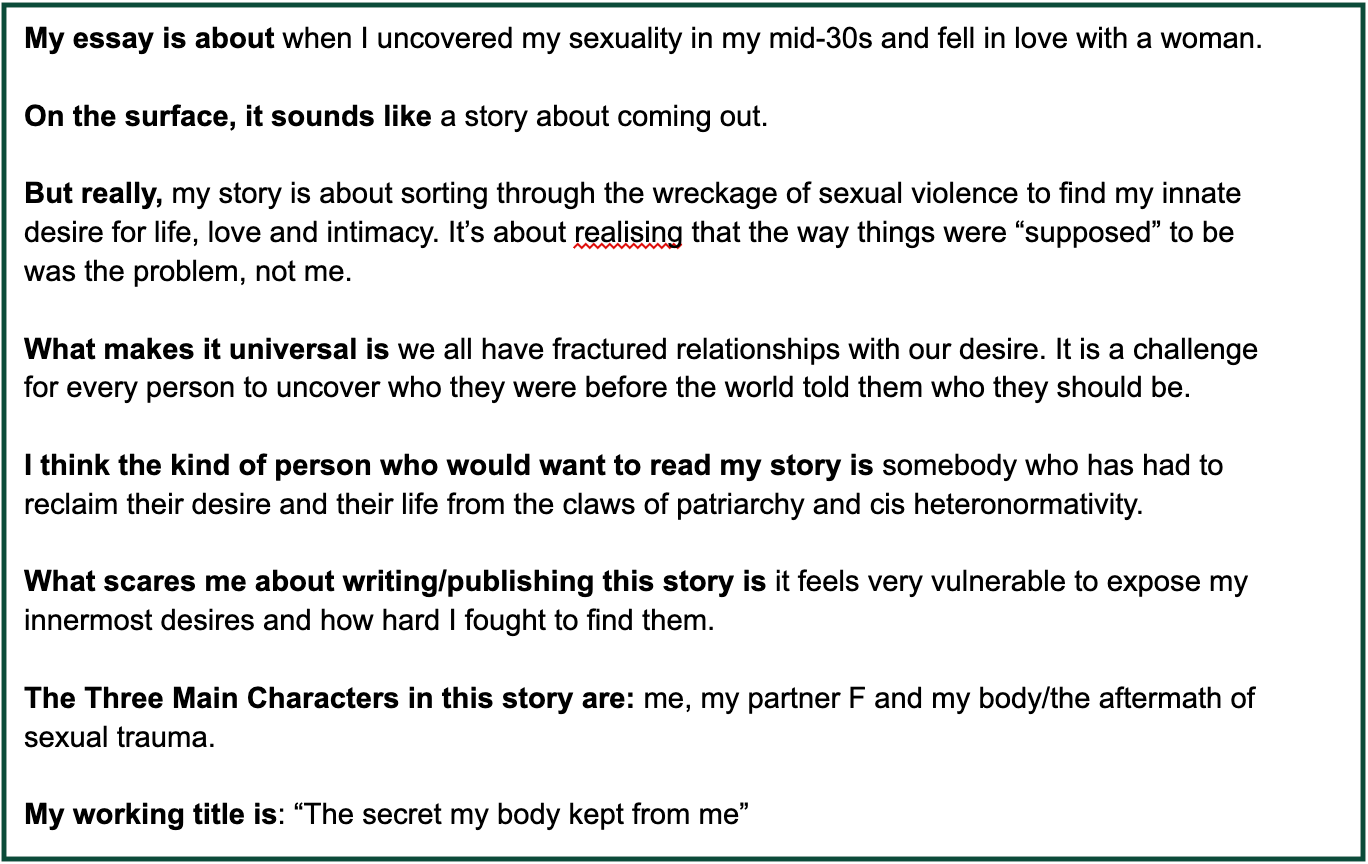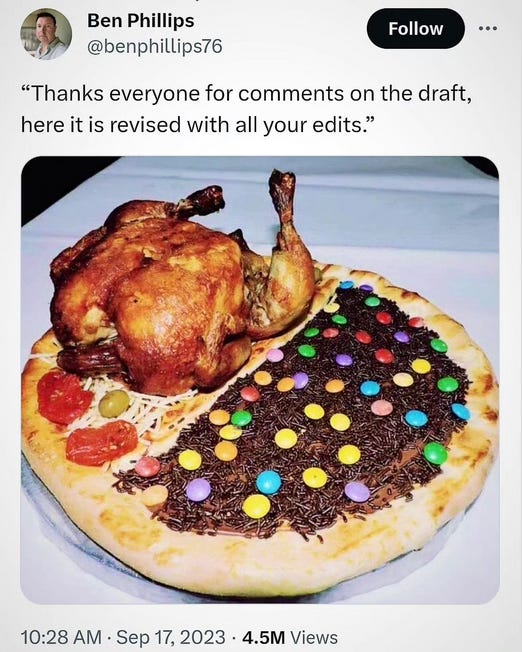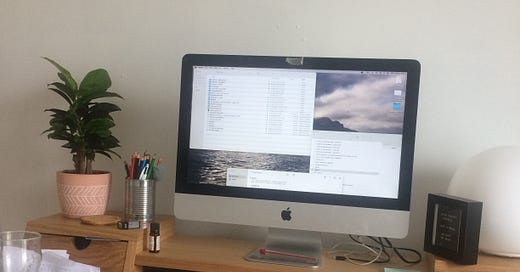How I wrote my personal essay for the Huffington Post
Some behind the scenes tips on pitching, how much I was paid etc
Last week, I published my first personal essay with the Huffington Post. Many of you discovered my work through that essay and have joined the growing community here at Life after Trauma. You are so welcome! Today, I’d like to share a little more about the process of drafting and submitting that essay and to answer any questions you have.
Before we start, a quick re-introduction: I’m Clare Egan. I’m a queer Irish writer, on a mission to change how we think about life after trauma. I founded Life after Trauma in 2023 because I wanted a space for survivor-centred conversations about recovering after sexual violence. If you’d like to support my work, please consider becoming a paid subscriber. It means a lot!
Writing the essay
I started working on this essay in February 2023. I was taking a class on The New York Times’s Modern Love column and the teacher encouraged us to explore one of our most emotionally difficult experiences on the page. The early drafts were painful to write. I could only get words on the page by privately agreeing that I’d never try to publish it.
When I’m writing autobiographically, I always have a lot of material to work from. I started by revisiting the journals I kept as a younger person and sorted through what I’d written in real time. This is always a laborious part of the process. I read everything, captured the themes and scenes I wanted to include and assembled a loose timeline.
I experimented with different ways of framing the essay - would I play up the time I spent in Belfast, allowing the conflict in Northern Ireland to be the backdrop to my experiences? Would I highlight my Catholicism and my relationship with my mother? Would I take a more theoretical ‘heteronormativity limits us all’ angle? I also had to decide which specific experiences with men would be included.
The only way to answer those questions was to write my way through them.
I wrote many, many thousands of words, trying to feel my way toward the frame that would best accommodate the story I wanted to tell. I did some framing exercises provided by the teacher, which were useful. But as you can see from the screenshot, the final essay diverged pretty radically from my early thinking.

Since I was aiming for the Modern Love column, I read dozens of published essays and analysed what worked and what didn’t. I thought tactically about how I wanted to hook readers: which of their questions would I answer in the early part of the essay and which questions would I leave them wondering about? The opening lines of the essay (which have remained the same since that early draft) highlight the choices I made on that:
“Of all the people I thought I might grow up to be, a lesbian wasn’t one of them. I never fantasised about women or imagined loving them. I didn’t have crushes on women or crave their attention. But looking back at my childhood self, I see a tiny queer scrambling for recognition…”
After 16 grueling drafts, I had a version that felt imperfect, but solid. Something that captured the story I wanted to share, and could be polished into a stronger version of itself. I shared it with my teacher, who did not agree! I felt savaged by her comments which felt unnecessarily harsh and personal. I’ll write more about dealing with feedback another time but for now, suffice to say that I was deeply hurt by her comments and left the essay aside to give myself some space to heal.
Four months later, in July 2023, I shared a slightly-revised draft with a handful of readers. Some really liked it and recommended no changes. Others felt that I was trying to squeeze too much story into too few words and suggested that I write a longer version. That would mean abandoning Modern Love as a potential publication venue, as those essays run at 1,700 words. I agreed, but did nothing about it for another five months.
By November 2023, I had another draft. It was longer and richer in terms of scene and narrative. I shared it with another editor who responded with insightful comments and questions. I decided to hire her to help me to get this essay ready for publication.
We began working together in January 2024, and I did many, many more versions of the essay. With smart questions and hard work, the essay got tighter with every pass. By February, she emailed to say that my latest draft was “very close” but when I opened the document, there were 54 comments and suggested changes on a 1,500 word essay. So, not that close!
By April 2024, I’d shared another draft, which she didn’t have any substantive comments on. After 16 months and dozens of drafts, the essay was finally complete.
Publishing the essay
I submitted the completed essay to Huff Post’s, Noah Michelson in early May and he responded quickly to say that he liked it! I’d also submitted it elsewhere, but withdrew it when Huff Post said yes. I worked with Huff Post’s Emily McCombs to finalise the essay, going back and forth on edits, photos, captions, questions from the copy desk and the practicalities of getting paid. I’ve heard positive things from other writers about publishing at Huff Post and have to agree that it was a smooth and lovely experience. In part, that’s probably due to the fact that I spent so long perfecting this essay before submitting it. But working with editors isn’t always a great experience and the Huff Post team were among the best I’ve ever worked with.
I’m very proud of the essay and was delighted when it was published, but I also wanted to hide under the covers! I got some lovely comments from readers, many of whom saw their own experience in my writing. Those kind words were incredibly humbling and I’ve saved every single comment. Sixteen months is a long time for an essay to be loitering in the ‘in progress’ folder, but I learned a lot from the publishing process.
Some things I learned:
You can’t do it for the money.
After more than a year of work, I was paid $150. That won’t even cover the cost of the editor I hired to polish the essay, but I still think it was worth it. What I learned about writing, the lovely comments I got from readers and the wider audience I’ve found for my work made this experience worthwhile.
Writing many, many drafts doesn’t unnecessarily mean eroding the core of the essay
In the folder where I stored this essay, there are 82 documents. Not all of them are new drafts but the vast majority are. As a younger writer, I worried that over-working my writing would make it feel dry and lifeless. Writing this essay has shown me that this isn’t always the case.
Don’t worry about efficiency
Was there a more efficient way to write this story? Probably, yes. But this was the only way I knew how to write it, and it resulted in an essay I’m really proud of. The writing process was messy because of my inexperience, but also because I was figuring out what I wanted to say.1
Write for yourself first
This essay only exists because I wrote it for myself first. If I’d been thinking about other people while writing those early drafts, I’d never have gotten anything on the page. As writers, we must develop a sense of safety2 around our work. We have to figure out what allows us to write authentically and for me, carefully considering the boundaries around what I’m willing to share and what I want to keep for myself make this work possible.
Chronology is very clarifying.
Whenever I got stuck, I returned to the chronology of my story. Putting things in order helped me to see the story more clearly, and figure out what I needed to write next.
Don’t underestimate the power of writing your way through.
Most of the time I was writing this essay, I was writing to figure out what I wanted to say. Every Most of the questions I had about this essay were answered by the process of writing it.
Cut, but never delete
I cut thousands of words from this essay but never deleted anything. As I write, I always have an ‘extras’ document where I compile the things that aren’t working. I later go back through the document and see what can be salvaged or repurposed. I think of these scraps as compost heap; maybe they’ll go on to live in other essays, or maybe it was writing I needed to do to get to the things I wanted to say. Either way, everything is necessary. Nothing is wasted.
Be careful who you listen to.
Many people read this essay and provided feedback, but not all of it was helpful. If you incorporate everyone’s feedback, you’ll end up with this:

The best editors ask smart questions and leave space for you to find answers.
The editor I hired had zero commentary about my personal life and choices, but lots of thoughts about the strengths and gaps in the essay. Hiring her was one of the best decisions I made for my writing this year!
Stick with it
After getting such harsh criticism on this essay last Spring, I thought about abandoning it. I’m glad I didn’t. I took the time I needed to heal, and got back to work. It’s lovely to see my name in print and to hear from readers who enjoyed the essay, but I’m most proud of the fact that I didn’t give up.
Thank you for reading. If you enjoyed this essay, you might also like:
💕 If this essay resonated with you, please tap the heart below to help spread the word.
✍️ If you’d like to write an essay for Huff Post, you can find more information here. I’m also happy to answer questions in the comments!
If you're curious about word counts, the length of this essay has fluctuated wildly over the last 16 months. It began at 1,863 words (the draft for the Modern Love class), grew to 3,368 words (the first draft I shared with the editor I hired) and finally published at 2,233 words.
Hat tip to The Artist's Way for that phrase.







I love reading about the work that went into your work! I’m about to start sending out on submission an essay I’ve been writing since March/April and have been researching since last October. It feels like an insane amount of time to put into something with no guarantee of a result, but your post is a reminder that even though we live in an age of seeming immediacy and churn, often, good things take time.
Thank you for sharing your process. You certainly have perseverance! Underneath that must be a confidence in yourself that is unshakable—even when you feel like giving up. I admire that!